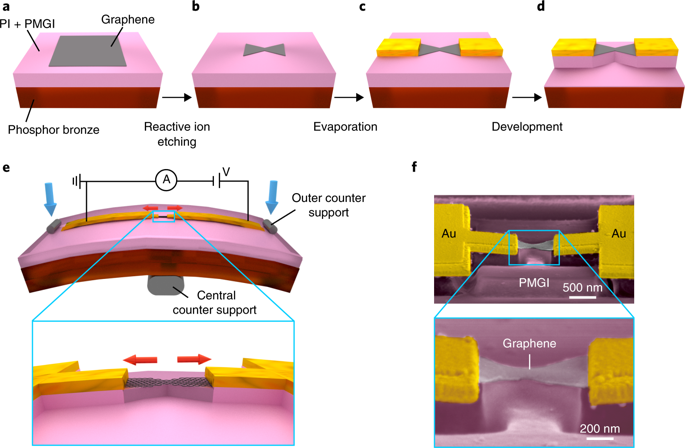Nature Nanotechnology ( IF 38.1 ) Pub Date : 2018-09-17 , DOI: 10.1038/s41565-018-0258-0 Sabina Caneva , Pascal Gehring , Víctor M. García-Suárez , Amador García-Fuente , Davide Stefani , Ignacio J. Olavarria-Contreras , Jaime Ferrer , Cees Dekker , Herre S. J. van der Zant

|
The ability to detect and distinguish quantum interference signatures is important for both fundamental research and for the realization of devices such as electron resonators1, interferometers2 and interference-based spin filters3. Consistent with the principles of subwavelength optics, the wave nature of electrons can give rise to various types of interference effects4, such as Fabry–Pérot resonances5, Fano resonances6 and the Aharonov–Bohm effect7. Quantum interference conductance oscillations8 have, indeed, been predicted for multiwall carbon nanotube shuttles and telescopes, and arise from atomic-scale displacements between the inner and outer tubes9,10. Previous theoretical work on graphene bilayers indicates that these systems may display similar interference features as a function of the relative position of the two sheets11,12. Experimental verification is, however, still lacking. Graphene nanoconstrictions represent an ideal model system to study quantum transport phenomena13,14,15 due to the electronic coherence16 and the transverse confinement of the carriers17. Here, we demonstrate the fabrication of bowtie-shaped nanoconstrictions with mechanically controlled break junctions made from a single layer of graphene. Their electrical conductance displays pronounced oscillations at room temperature, with amplitudes that modulate over an order of magnitude as a function of subnanometre displacements. Surprisingly, the oscillations exhibit a period larger than the graphene lattice constant. Charge-transport calculations show that the periodicity originates from a combination of the quantum interference and lattice commensuration effects of two graphene layers that slide across each other. Our results provide direct experimental observation of a Fabry–Pérot-like interference of electron waves that are partially reflected and/or transmitted at the edges of the graphene bilayer overlap region.
中文翻译:

石墨烯断裂键合中的机械控制量子干涉
检测和区分量子干扰信号的能力对于基础研究和实现诸如电子谐振器1,干涉仪2和基于干扰的自旋滤波器3之类的设备都很重要。根据亚波长光学原理,电子的波特性会引起各种类型的干涉效应4,例如法布里-珀罗共振5,法诺共振6和阿哈罗诺夫-波姆效应7。量子干扰电导振荡8实际上,已经为多壁碳纳米管航天飞机和望远镜进行了预测,并且是由于内管和外管之间的原子级位移9,10引起的。石墨烯双层的先前理论工作表明,这些系统可能会显示出类似的干扰特征,这是两个薄片11,12相对位置的函数。但是,仍然缺乏实验验证。石墨烯nanoconstrictions代表一个理想的模型系统研究量子输运现象13,14,15由于电子相干16和载流子的横向限制的17。在这里,我们演示了由机械控制的石墨烯单层制成的蝶形领结形纳米缩颈的制造。它们的电导率在室温下显示出明显的振荡,其幅度根据亚纳米级位移而调制一个数量级。令人惊讶地,振荡表现出比石墨烯晶格常数大的周期。电荷传输计算表明,周期性源自两个相互滑动的石墨烯层的量子干扰和晶格共存效应的组合。我们的结果提供了对在石墨烯双层重叠区域边缘部分反射和/或透射的电子波的法布里-珀罗特样干扰的直接实验观察。











































 京公网安备 11010802027423号
京公网安备 11010802027423号